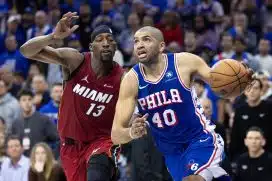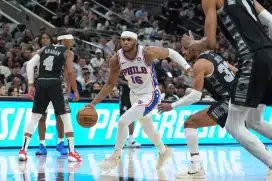By Matt Gregan, Sports Talk Philly Staff Writer
The Philadelphia 76ers got off to a good start in their Eastern Conference quarterfinals series against the Toronto Raptors largely on the back of finding a successful winning formula to combat Toronto's strengths. In the first two games of the series, the Sixers played efficient basketball, controlled the ball and largely prevented Toronto from getting out in transition.
Things started to crack in Game 3, but a dominant performance from Joel Embiid in the second half and overtime allowed them to come away with the win. In Game 4, the Sixers failed to come away with the sweep as the team mostly went away from the things that had resulted in their successful start to the series.
In Games 1 and 2, the Sixers played clean basketball, committing only 8.5 turnovers per game while effectively spreading the ball all around the floor. Games 3 and 4 were a different story. The Sixers turned the ball over 22 and 15 times respectively, leading to 27 points off turnovers in Game 3 and 22 points off turnovers in Game 4.
The turnover problems were team-wide, but there was one in player in particular who struggled in that department. Embiid committed a combined 11 turnovers over his last two games. He had a ton of difficulty handling the multitude of double teams the Raptors sent in his direction. Below is a highlight clip of three of his turnovers from the loss in Game 4:
Notice the common theme among all three plays shown: Rushing the ball out of the double team. He needed to play with more patience. Multiple of those turnovers came from a rushed cross-court pass out of a double team that Toronto jumped on, leading directly to easy points. Similarly to how a quarterback in football needs to have an internal clock to sense and feel the pressure coming from his blind side, Embiid's internal clock seemed to be off in Game 4.
Two of the turnovers shown above could have been avoided if Embiid let the game slow down. In the last two plays of the clip above, the Sixers got the look they wanted. Toronto sent a double team over to Embiid, leaving one defender to cover two Sixers players on the other side of the court. Embiid, instead of reading the defense, rushed both passes right to players where the Toronto defender was scrambling to.
The turnovers were a big issue for Embiid and the Sixers as a team. However, there were some moments throughout Games 3 and 4 where Embiid patiently handled the double teams. Below is a highlight clip with some of those moments from the prior two games:
When Embiid lets the game slow down and come to him, he is more than capable of effectively handling double teams and setting the Sixers up for good scoring opportunities. He has made a ton of improvement in this area of his game, so his struggles the last two games are likely just a hiccup rather than something to be worried about throughout the remainder of the playoffs.
Embiid hurt his thumb in the first half of Game 3 back on Wednesday, and an MRI on Sunday afternoon confirmed he has a ligament tear in his right thumb. This reportedly will not change his availability going forward. He will play through it with a combination of pain tolerance and whatever the team's medical staff can do (tape, soft splint, etc).
The Sixers' superstar center struggled to find his shot in the first game after the injury, shooting just 7 of 16 in Game 4. With Embiid clearly not at 100 percent, having the supporting cast step up will become even more important for the Sixers. Tobias Harris is one of the team's only players who has had a consistently good series. He is averaging 18.0 points on 58.7 percent shooting from the field to go with 9.8 rebounds and 1.8 blocks per game so far in this series.
Tyrese Maxey played efficient, effective basketball early in the series. He averaged 30.5 points on 68.8 percent shooting from the field and 57.1 percent shooting from three-point range in the first two games of the series. He got to his spots, whether they were beyond the arc or inside the painted area.
His performance started slipping in Games 3 and 4, which is to be expected from a 21-year-old playing in his first postseason as a starter. He put together a solid performance in Game 3, finishing with 19 points on 8-of-18 shooting. He struggled in Game 4, scoring 11 points on 4-of-12 shooting from the field. A lot of his shots came out of rhythm. The Sixers need to make a better effort to consistently keep him more involved in the offense so he can stay in rhythm.
The Sixers also need a better performance from James Harden. His numbers on paper are solid, but then dive deeper and they start to look more underwhelming. So far in the series he is averaging 19.3 points (37.5 percent from the field, 39.1 percent from three-point range), 5.5 rebounds, 9.8 assists and 3.3 turnovers per game. The Sixers simply need more from him in the scoring department, especially with Embiid laboring through a thumb injury to his shooting hand.
Regardless of what the Sixers' supporting cast does, the team will have to rediscover their formula for success from the first two games of the series. In addition to not turning the ball over, the formula consists of limiting both Toronto's second-chance and fast-break points. The Sixers controlled both of those areas in the first two games of the series, outscoring Toronto 29-22 in second-chance points and 51-20 in fast-break points. However, the advantage swung Toronto's way in Games 3 and 4, with the Sixers getting outscored in second-chance points 28-16 and in fast-break points 34-14.
The Sixers found a successful formula to beat Toronto in Games 1 and 2 centered around not turning the ball over, receiving strong performances from throughout the roster and winning in a few other key statistical categories (second-chance points and fast-break points). Rediscovering this successful formula will play a large part in determining if the Sixers can end this series in five games.







